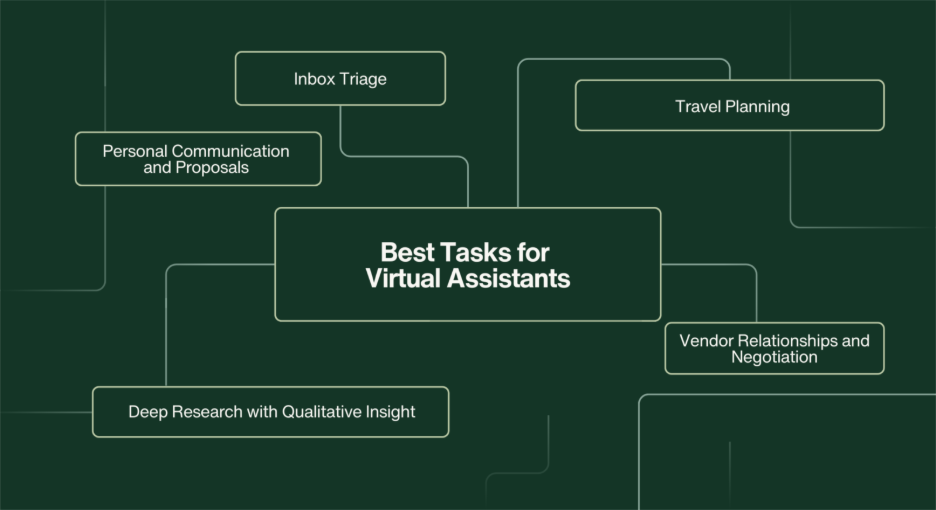AI Automation Agency & Virtual Assistant Agency: How They Work Together for Executives
At a glance
Executives and leaders are increasingly turning to an AI automation agency & virtual assistant agency model to scale productivity without burning out. By combining intelligent automation with expert human support, this hybrid approach allows time-strapped professionals to delegate both routine tasks and strategic work.
An AI automation agency builds systems and software to streamline repetitive processes, while a virtual assistant agency supplies human talent to manage judgment-driven tasks. When these two work together, executives benefit from speed, precision, and flexibility.
In this article, we will explore how these two types of agencies differ, whether one can replace the other, which tasks to delegate to each, how AI tools can elevate virtual assistant services, and why a hybrid model may define the future of executive support.
What Is an AI Automation Agency and How Does It Differ from a Virtual Assistant Agency?
An AI automation agency & virtual assistant agency might sound like overlapping services, but their roles are fundamentally different.
An AI automation agency designs, builds, and maintains systems that automate workflows. These can include data entry pipelines, lead generation flows, email parsing, and other rule-based or AI-augmented processes. Their goal is to reduce manual burden and scale operations efficiently.
On the other hand, a virtual assistant agency focuses on people. Its assistants manage tasks that require judgment, discretion, relationship skills, adaptability, and strategic thinking; areas where automation alone falls short. This includes communications, prioritization, coordination, and complex tasks with ambiguity.
In short, automation agencies optimize systems, while virtual assistant agencies optimize human output. Each has strengths, and together they form a powerful toolkit for executives.
Can an AI Automation Agency Replace a Virtual Assistant Agency for CEOs?
The short answer is no. Automation cannot fully replace human support for executive roles.
While AI can filter emails, generate reports, or schedule recurring reminders, it cannot build rapport, anticipate needs, or inject nuance into communications. A virtual assistant can intervene when subtleties matter, such as drafting investor responses, smoothing team conflicts, or making judgment calls.
For this reason, an AI automation agency & virtual assistant agency model should be viewed as complementary rather than competitive. Automation handles the background tasks, while human assistants step in where context and relationships are essential.
What Tasks Should You Delegate to AI Automation vs a Virtual Assistant?
Knowing which tasks to hand off to technology and which to delegate to human support is key to unlocking productivity.

Best tasks for AI automation:
- Bulk data entry, cleanup, and transformations
- Updating CRM records and lead flows
- Automated reminders, invoice follow-ups, and simple email triggers
- Recurring task scheduling and workflow triggers
- Dashboard generation, basic analytics, and report summaries

Best tasks for virtual assistants:
- Inbox triage with judgment on context and priority
- Drafting personal communication, proposals, or narrative documents
- Travel planning that considers human preferences
- Vendor relationships, negotiation, or handling escalations
- Deep research that needs discretion or qualitative insight
When these two are combined, executives can offload repetitive tasks while ensuring quality control and discretion in higher-leverage work.
How Do AI Tools Enhance the Services of a Virtual Assistant Agency?
Virtual assistant agencies that integrate AI tools into their workflows deliver far more value than those that do not.
Assistants can use AI to automate routine admin, freeing bandwidth for strategic efforts. Scheduling tools can reduce conflicts and optimize calendars. Natural language models can help draft outlines or synthesize research. Data tools can surface trends for decision support.
By using a hybrid model, clients benefit from speed, accuracy, and human oversight. It is not a choice between an AI automation agency & virtual assistant agency. Instead, it is about combining both to meet executive needs.
Why HireHarbour Virtual Executive Assistants Are AI-Savvy
One key differentiator is that HireHarbour virtual executive assistants are trained to be AI native, blending human judgment with automation fluency.
Our assistants are not just familiar with tools. They use them to multiply output. From automating workflows to employing large language models for drafting or research, every EA knows when to execute manually and when to harness AI.
For example, a ten-page client report was drafted in 20 minutes, work that would otherwise take two hours. Another EA automated a weekly reporting workflow in just days.
Their training includes hours of foundational skills, followed by layered AI instruction: prompt engineering, tool integration, and safe deployment practices. Regular upskilling also keeps them ahead as tools evolve.
The result is a level of leverage and precision rarely seen from traditional assistants. Instead of working harder, executives get time back to think, strategize, and lead.

What Are the Cost Differences Between an AI Automation Agency and a Virtual Assistant Agency?
Cost is a critical element when evaluating support models.
- AI automation agencies typically charge based on project scope or a subscription model. Upfront costs may be high, but the value compounds when systems scale.
- Virtual assistant agencies usually charge hourly or via retainer structures. Costs scale with the amount of human hours required.
A hybrid approach often delivers the best return on investment. Automation reduces repetitive labor costs, and human assistants ensure quality execution.
Conclusion
Is a Hybrid Model (AI + Human EAs) the Future of Executive Support?
Yes. Hybrid models are quickly becoming the new standard in executive support.
AI handles foundational, repetitive work such as data transformation, rule-based tasks, and internal consistency. Human EAs step in for judgment, prioritization, communication, and relationship tasks.
This blend provides leaders with both speed and nuance. It frees executives from being reactive and allows them to focus on proactive leadership. For those seeking maximum leverage, the future lies in unified AI plus human support.
Ready to make every second count?



.svg)

.png)

